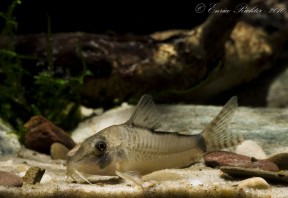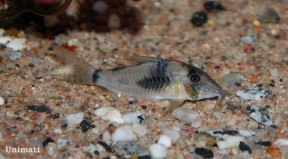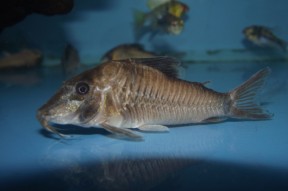Corydoras simulatus
Etymology
Corydoras: from the Ancient Greek κόρυς (korus), meaning ‘helmet’, and δορά (dora), meaning ‘skin, hide of an animal’, in allusion to the rows of bony plates on the flanks of genus members.
simulatus: from the Latin simulatus, meaning ‘imitate’ or ‘copy’, in allusion to the species’ resemblance to the congener Corydoras metae.
Classification
Order: Siluriformes Family: Callichthyidae
Distribution
Type locality is given as ‘Río Ocoá near Puerto López, 4°06’N, 72°57’W, River Meta system, Meta, Colombia’, and this species is known only from the upper Meta watershed.
Habitat
Maximum Standard Length
60 – 70 mm.
Maintenance
Ideally use a substrate of fine sand, although rounded gravel is an acceptable alternative provided it’s kept scrupulously clean.
Other décor is largely down to personal choice, but some cover should be provided to give the fish security.
Water Conditions
Temperature: 20 – 25 °C
pH: 6.0 – 7.0
Hardness: 36 – 215 ppm
Diet
Corydoras spp. are foraging omnivores and will accept most sinking dried foods, as well as small live and frozen varieties such as bloodworm, Tubifex, etc.
Feeding a varied diet will ensure the fish are in optimum condition.
Under no circumstances should they be expected to survive on ‘left-overs’ from other inhabitants of the aquarium or relied on to ‘clean’ the aquarium.
Behaviour and CompatibilityTop ↑
Peaceful and gregarious. Should be maintained in a group of at least 4-6 individuals.
Sexual Dimorphism
Females are noticeably rounder and broader-bodied, especially when gravid, and grow approximately 5 mm larger than males.
NotesTop ↑
This species can be identified from most similar-looking congeners by possession of a pair of small rictal barbels.
Unfortunately additional diagnostic characters cannot be provided since we’ve been unable to obtain the type description, and little has been written about this species since it was published.
Its colour pattern can vary considerably depending on collection locality, with some forms having been misidentified as other species in the past.
Those possessing a dark marking on the sides of the body are sometimes referred to as Corydoras sp. ‘olga’.
The genus Corydoras is among the largest catfish groups and currently contains over 150 valid species.
It’s included in the family Callichthyidae, of which members are often referred to collectively as ‘armoured’ or ‘mailed’ catfishes group due to the presence of bony plates in place of scales on the body.
Their taxonomy can be confusing, and numerous undescribed species are also thought to exist.
Fish of unconfirmed identification entering the aquarium hobby are therefore typically assigned a ‘C‘ or ‘CW‘ number for purposes of reference and organisation.
They are facultative air breathers and possess a modified, highly vascularised intestine which has evolved to facilitate uptake of atmospheric oxygen and aid survival in oxygen-deprived environments. In the aquarium you’ll occasionally see them rising to the surface to take in gulps of air.
The stiffened pectoral-fin spines are capable of piercing human skin and a ‘sting’ can be very painful indeed, so care should be exercised when handling them.
It’s thought that secretions from the axillary glands at the base of each spine may even be mildly toxic or venomous.
References
- Reis, R. E., S. O. Kullander, and C. J. Ferraris, Jr. (eds) , 2003 - EDIPUCRS, Porto Alegre: i-xi + 1-729
Check list of the freshwater fishes of South and Central America. CLOFFSCA.





